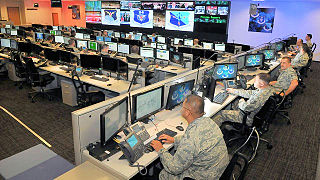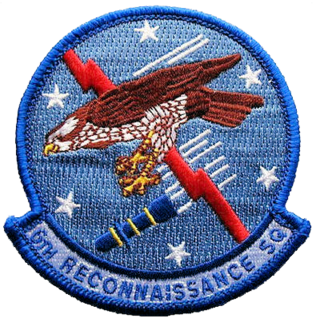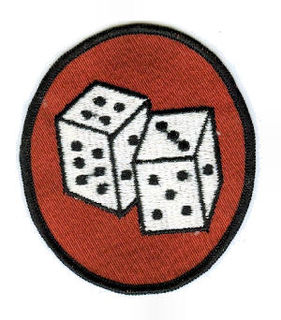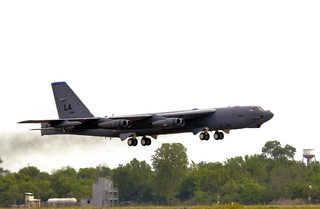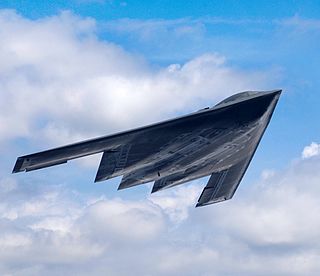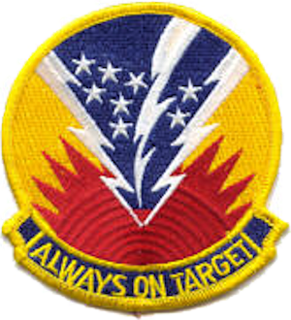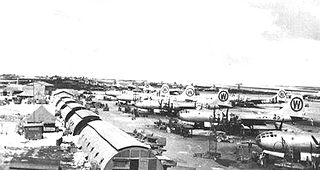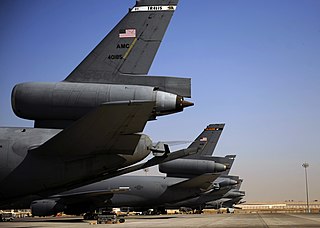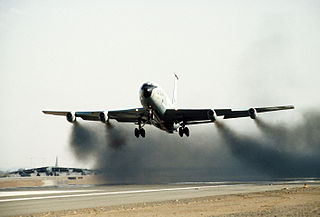93d Bomb Squadron  | |
|---|---|
 93d Bomb Squadron B-52H Stratofortress [note 1] | |
| Active | 1917–1919; 1935–1936; 1939–1944; 1944–1963; 1993–present |
| Country | |
| Branch | |
| Type | Squadron |
| Role | Bombardment |
| Part of | Air Force Reserve Command |
| Garrison/HQ | Barksdale Air Force Base, Louisiana |
| Nickname(s) | Indian Outlaws |
| Engagements |
|
| Decorations |
|
| Insignia | |
| 93d Bomb Squadron emblem [1] |  |
| 93d Bombardment Squadron emblem (approved 24 April 1942) [2] |  |
| 93d Aero Squadron fuselage marking (approved by AEF 18 November 1918) [3] |  |
| Tail Code | BD |
The 93d Bomb Squadron is a squadron of the United States Air Force Reserve. It is assigned to the 307th Operations Group of Air Force Reserve Command, stationed at Barksdale Air Force Base, Louisiana. The squadron is equipped with the Boeing B-52 Stratofortress. It is one of two reserve bomber squadrons in the United States Air Force. [1]

The 307th Operations Group is an Air Reserve Component (ARC) of the United States Air Force. It is assigned to the 307th Bomb Wing, Air Force Reserve Command, stationed at Barksdale Air Force Base, Louisiana.

The Air Force Reserve Command (AFRC) is a Major Command (MAJCOM) of the United States Air Force, with its headquarters at Robins Air Force Base, Georgia. It is the federal Air Reserve Component (ARC) of the U.S. Air Force, consisting of commissioned officers and enlisted airmen.

Barksdale Air Force Base is a United States Air Force base in northwest Louisiana, USA, in Bossier Parish. It is contiguous to Bossier City, Louisiana along the base's western and northwestern edge. Barksdale Air Force Base occupies more than 22,000 acres east of Bossier City and along the southern edge of Interstate Highway 20. More than 15,000 active-duty and Air Force Reserve members serve at Barksdale.
Contents
- Mission
- History
- World War I
- Battle of the Philippines (1942)
- B-29 Superfortress operations against Japan
- Korean War
- Strategic Air Command
- Air Force reserve
- Lineage
- Assignments
- Stations
- Aircraft Operated
- See also
- References
- Bibliography
- External links
The 93d is one of the oldest and most decorated units in the United States Air Force. Its first predecessor was organized as the 93d Aero Squadron on 21 August 1917 at Kelly Field, Texas. The squadron deployed to France and fought on the Western Front during World War I as a pursuit squadron. The unit was demobilized after the war in 1919.

The Western Front was the main theatre of war during the First World War. Following the outbreak of war in August 1914, the German Army opened the Western Front by invading Luxembourg and Belgium, then gaining military control of important industrial regions in France. The tide of the advance was dramatically turned with the Battle of the Marne. Following the Race to the Sea, both sides dug in along a meandering line of fortified trenches, stretching from the North Sea to the Swiss frontier with France, which changed little except during early 1917 and in 1918.

World War I, also known as the First World War or the Great War, was a global war originating in Europe that lasted from 28 July 1914 to 11 November 1918. Contemporaneously described as "the war to end all wars", it led to the mobilisation of more than 70 million military personnel, including 60 million Europeans, making it one of the largest wars in history. It is also one of the deadliest conflicts in history, with an estimated nine million combatants and seven million civilian deaths as a direct result of the war, while resulting genocides and the 1918 influenza pandemic caused another 50 to 100 million deaths worldwide.
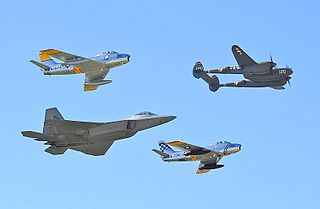
A fighter aircraft is a military aircraft designed primarily for air-to-air combat against other aircraft, as opposed to bombers and attack aircraft, whose main mission is to attack ground targets. The hallmarks of a fighter are its speed, maneuverability, and small size relative to other combat aircraft.
The squadron's second predecessor was constituted as the 93d Attack Squadron in 1929 as part of the United States Army Air Corps. The squadron deployed to the Philippines as the 93d Bombardment Squadron in 1941, engaging in combat during the 1941-42 Battle of the Philippines at the beginning of World War II. Withdrawn to Australia, it fought in the Dutch East Indies campaign before returning to the United States and being re-equipped with Boeing B-29 Superfortress bombers. It returned to the Pacific Theater of Operations in early 1945 to carry out strategic bombing missions over the Japanese Home Islands. [2]

A squadron in air force, army aviation, or naval aviation is a unit comprising a number of military aircraft and their aircrews, usually of the same type, typically with 12 to 24 aircraft, sometimes divided into three or four flights, depending on aircraft type and air force. Land based squadrons equipped with heavier type aircraft such as long-range bombers, or cargo aircraft, or air refueling tankers have around 12 aircraft as a typical authorization, while most land-based fighter equipped units have an authorized number of 18 to 24 aircraft.

The United States Army Air Corps (USAAC) was the aerial warfare service of the United States of America between 1926 and 1941. After World War I, as early aviation became an increasingly important part of modern warfare, a philosophical rift developed between more traditional ground-based army personnel and those who felt that aircraft were being underutilized and that air operations were being stifled for political reasons unrelated to their effectiveness. The USAAC was renamed from the earlier United States Army Air Service on 2 July 1926, and was part of the larger United States Army. The Air Corps became the United States Army Air Forces (USAAF) on 20 June 1941, giving it greater autonomy from the Army's middle-level command structure. During World War II, although not an administrative echelon, the Air Corps (AC) remained as one of the combat arms of the Army until 1947, when it was legally abolished by legislation establishing the Department of the Air Force.

The Philippines Campaign or the Battle of the Philippines, fought 8 December 1941 – 8 May 1942, was the invasion of the Philippines by Imperial Japan and the defense of the islands by United States and Filipino forces during the Second World War.
During the Cold War it carried out B-29 bombardment missions over North Korea during the Korean War, later being a Boeing B-47 Stratojet and Boeing B-52 Stratofortress squadron as part of Strategic Air Command. [2]

The Cold War was a period of geopolitical tension between the Soviet Union with its satellite states, and the United States with its allies after World War II. A common historiography of the conflict begins with 1946, the year U.S. diplomat George F. Kennan's "Long Telegram" from Moscow cemented a U.S. foreign policy of containment of Soviet expansionism threatening strategically vital regions, and ending between the Revolutions of 1989 and the 1991 collapse of the USSR, which ended communism in Eastern Europe. The term "cold" is used because there was no large-scale fighting directly between the two sides, but they each supported major regional conflicts known as proxy wars.

The Korean War was a war between North Korea and South Korea. The war began on 25 June 1950 when North Korea invaded South Korea following a series of clashes along the border.

The Boeing B-47 Stratojet is a retired American long-range, six-engined, turbojet-powered strategic bomber designed to fly at high subsonic speed and at high altitude to avoid enemy interceptor aircraft. The B-47's primary mission was as a nuclear bomber capable of striking the Soviet Union. With its engines carried in nacelles under the swept wing, the B-47 was a major innovation in post-World War II combat jet design, and contributed to the development of modern jet airliners.







